Real thread color cards – if you don’t know what they are, you should find out! Because I’m telling you, they’re the best thing since packaged chocolate.
You think I exaggerate? No, no!
A real thread color card is The Answer for needleworkers who like to design their own pieces or who like to reinterpret other designs and need to know what colors and shades are available in a specific line of thread.
For those who don’t have needlework shops on hand, real thread color cards are a much less expensive way of viewing the shades and colors in a thread line, in real life, without purchasing the whole collection of a particular thread.
If you’re not familiar with real thread color cards and how they work, never fear! Today, I’m going to show you what information you can usually find on a real thread color card, and the various ways you can put them to work for you.
For my model, I’m going to use DMC’s latest real thread color card, recently published, which includes their newly released colors.
A real thread color card is exactly what it sounds like – it’s a color card that sports samples of all the colors in a line of threads, using pieces of real threads.
When it comes to choosing colors for a project, the advantage of a real thread color card compared to a printed color card or an online color card (or photos of skeins) is pretty clear: there’s no guessing about how accurate the print rendition of a color card is, and there’s no guessing whether or not the electronic colors on the screen are accurate (they usually aren’t – computer screens vary in how they render color).
With a real thread color card, you can view an actual fragment of the thread you’re considering, being confident that, if you’ve taken care of your color card, the thread color you’re seeing is accurate.
But this isn’t the only advantage of a real thread color card!
Lots of Information
Another advantage is that the color card contains a lot of information about the thread, or about a line of threads. That’s right! It’s not just color you get – you get some extra and helpful information, too.
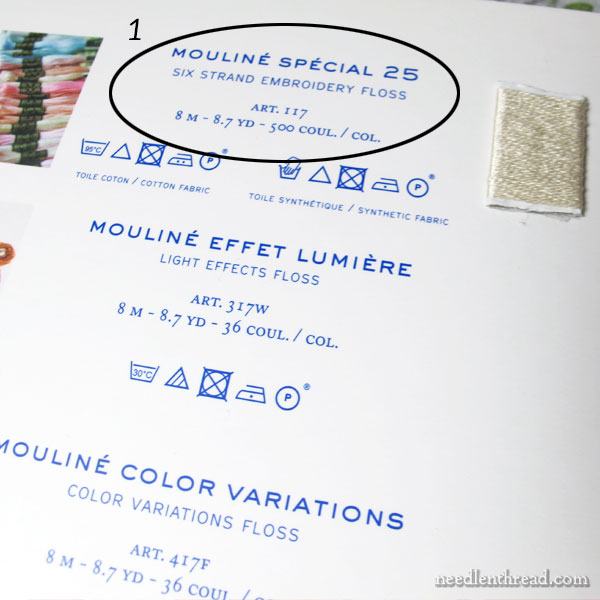
Using the DMC color card, and understanding that DMC produces a wide range of types of needlework thread, the extra information on the card is very helpful. It allows the user to see at a glance certain information on all their popular threads, all in one spot.
In the photo above, I’ve circled some of the key information that you can find on the thread card. In this case, the information is about DMC stranded cotton (“Mouliné Spécial 25” – or Art. 117, going by the product number).
You can see at a glance that each skein sports 8 meters (or 8.7 yards) of 6-stranded floss, and the number of colors in the range.

You can see laundering instructions for the product.
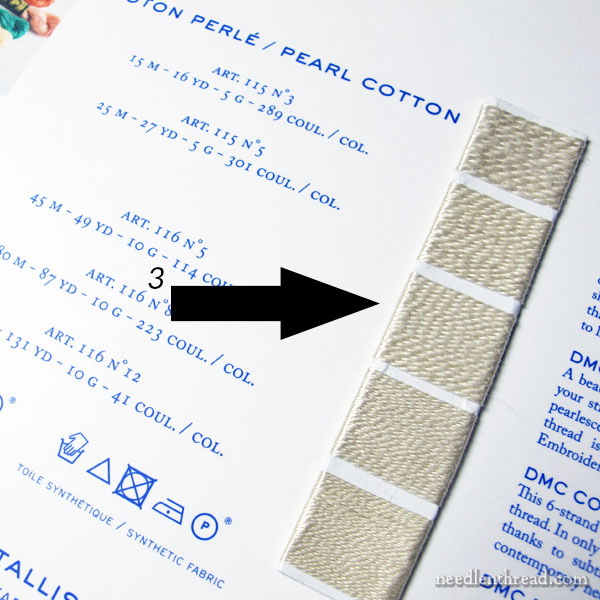
Next to the main threads in their collection, you’ll also find un-dyed thread samples, to help you see the structure and weight or thickness of the thread. In the photo above, the arrow points to undyed wraps of the various weights of DMC perle cotton.
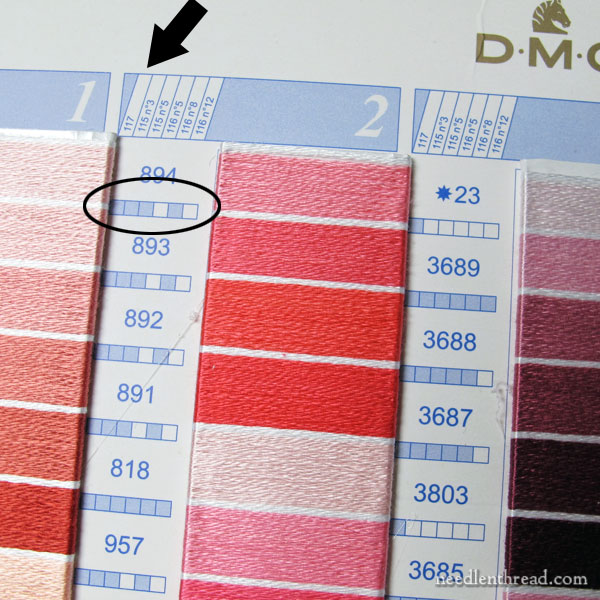
On the main part of the color card, where all the colored threads are neatly wound onto strips of cards, you’ll find information about the colors available in each type of thread.
At the top of the page of color strips, you can see the common thread types by DMC listed horizontally across the top of each information column (see where the arrow is pointing in the photo above). There’s 117, which is stranded cotton, followed by the perle cottons in skeins (3 and 5 – Art 115, in 16 and 27 yard skeins, respectively) and on balls (5, 8, and 12 – Art 116, in 49, 87, and 131 yard balls, respectively).
In the information column below the thread types, you’ll see a number next to each real thread sample (that’s the color number for that particular shade), plus a small horizontal grid with boxes filled in (circled in the photo above). Where the boxes are filled in, that particular shade is available in the corresponding weight of thread indicated at the top of the column.
So, in the sample circled above, you can see that color #894 is available in 6-stranded floss, perle cotton #3 and #5 (skeins) and perle cotton #8 (ball).
That’s excellent information to know, if you want to work with that particular color in several weights of thread.
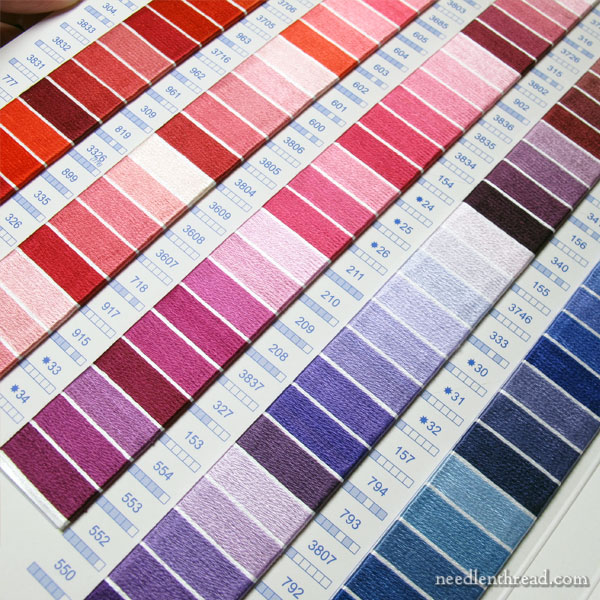
Color Conversion Across Brands
Another advantage of a real thread color card is that you can use it for color conversion across brands of threads, where a color conversion chart may not be available. This is particularly handy if you don’t have a local needlework shop close by.
With a universal brand like DMC, using their real thread color card, you can hunt out different brands and thread types that are available in similar colors and shades.
For example, imagine that you want to do a project that features certain shades of blue, but you want to work them in blue silks rather than cottons.
Say you like the range of blues on the DMC color card that are numbered 3746 through 794 in the photo above. Knowing those color numbers that correspond with the blues you’d like in silk, you can call your favorite needlework shop and tell them, “I’m looking for silk similar in color and shade to these numbers in DMC. Do you have any silks that fall in that range or close to it?”
Because DMC is rather universal, they can either consult the color card or look at the skeins and find something similar in the other lines of threads they carry. When you order the threads, you know you’ll be getting something pretty close to the color you were looking for.
While it may not get you an absolutely perfect match, it’ll get you pretty close!

Shade Groupings
Which brings me to the point of shade groupings!
Real thread color cards are generally arranged in color and shade groupings rather than numerical order. This makes it really easy to find a range of shades of a particular color.
I love this feature! While many shade ranges start with a run of adjacent color numbers, they don’t always rely on adjacent numbers to complete the line of shades available.
However, when you buy thread at a shop or online, it’s usually arranged in numerical order.
And this makes it difficult to see, when shopping, the whole available range of shades of a particular color.
Using the real thread color card, you know what numbers you need to look for, to get the complete shade range.
How to Get Them
Real thread color cards are not always available for every brand of thread – would that they were!
Even for brands that do produce them, they’re also not always available. Often, they’ll show up as available for a short while, then they’ll be out of stock, and then you won’t see them again for a long time!
DMC’s real thread color card with the new colors is available here right now. I don’t know how long it will be available – it was showing up as available for a little while, then out of stock for a while, and now it looks like it’s back in stock. If you want one, I’d say now’s the time to get one.
Appleton crewel wool has real thread color cards. They’re arranged a little differently, with snippets of their tapestry wool (same colors) on small cards that are held in a box. You can find them here through Wooly Thread. If you like crewel work and you work with Appleton frequently, they’re good to have!
And several other brands also make real thread color cards. To find out if your favorite thread brands make real thread color cards, contact either the thread manufacturer directly (start by looking at their website and inquire there) or ask at your favorite locally owned needlework shop.
Questions? Comments? Suggestions?
Anything to add to the conversation on real thread color cards? Feel free to have your say below!



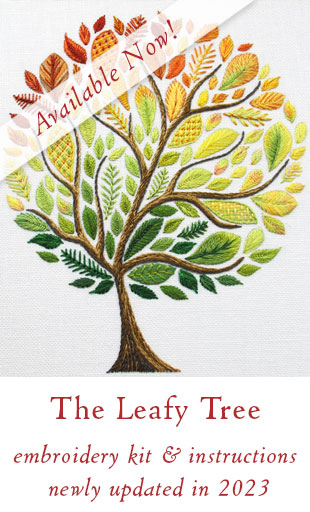
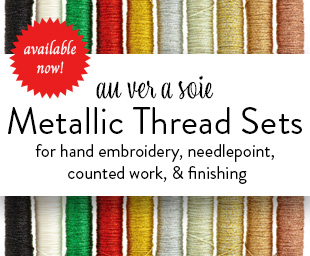

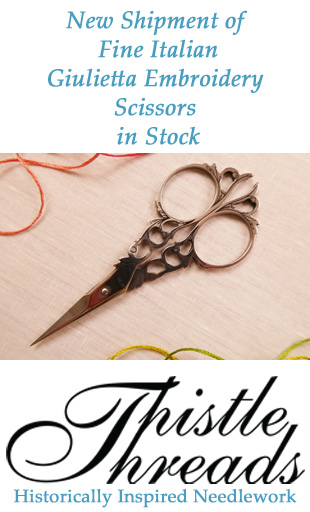
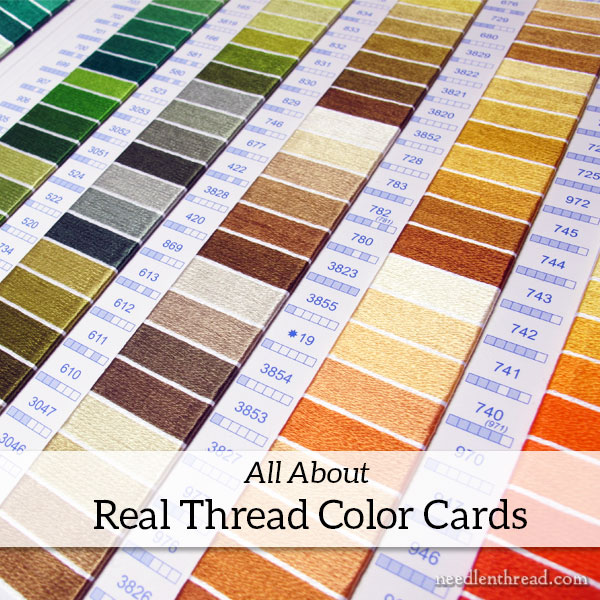
I’ve wanted one of these for a long time, and I just ordered one — thanks for the heads-up!
Thanks, Mary, for this description of color cards. You really explained each part of the card so clearly! And now I know why my thread colors don’t always match the pdf card that I have been using!
I don’t have the latest DMC color card, but I do have W100TC (maybe c. 2013?) and the earlier W100C. Absolutely wouldn’t want to be without it. And Mary, you’ve certainly hit on most of the features – there’s a lot packed in the color card. One more, is the numerical list that cross references the column number. I do hope they didn’t drop that.
One issue for me is that while it’s moderately priced, it’s a question of how often to update it as they bring out new colors. And for silks — I think I saw a quote of at least $60 (for RG Splendor?). I like your idea of using the DMC color numbers for ‘shopping’ remotely.
I have a large loose leaf binder with information on various thread lines. Some are official publications; some are printouts from websites. Information on discontinued threads is useful for making conversions.
Do you ever make up your own color cards? I’ve thought about it, but not sure of an efficient and effective way to do it, and update it as my stash expands.
Thank you, Mary. I have a number of real thread color cards I have collected over the years (though some are no doubt not entirely accurate anymore). But I have only ever had the printed one for DMC. This caught me on a day when I was willing to throw spending caution to the wind and my order has been placed! There really is nothing like having actual samples when trying to design and match colors. Thanks for the heads up.
Linda
Thank you so much for covering this topic. I have a very old Real Thread DMC chart that I use every time I kit up a new project when I am missing a color. Years ago they stopped selling them in the stores and nothing compares to having the real samples to look at instead of a picture.
I just ordered the new one successfully. Thank you for providing the link!
Jane
Thanks for the “enabling” this morning, Mary! I ordered a thread card. I’ve always wanted one.
Hi Mary, Once I bought a certain colour in DMC stranded cotton. I started running low on it and about 2 years later bought another string, exactly the same number. Only when I got home and compare the two I noticed there was a slight difference in colour. Not much, but noticeable. So I came to the conclusion that just as one gets dye lots in knitting thread, the same can apply to embroidery threads. I thought it a good hint to pass on.
Kind regards Elza, Cape Town xx
I absolutely love real thread color cards. For my machine sewing, I prefer 50wt 100% cotton Aurifil but, because I live in rural Maine, I cannot count on local shops having the color I want. The color card makes it possible to supplement my thread stash on line. I just ordered my DMC card for all of the reasons Mary stated today. I can’t wait to get it!
Good morning. In case you are wondering if your site is popular, it is.
The DMC site has just about crashed, whether entered via your link or search engine.
But undaunted, after I dump all their “cookies”, I will check to see if my order went through. DMC is a big company; I am sure they will sort it out.
I have wanted this card for a long time. Thank you for alerting us.
I agree! Color cards help tremendously. I have a collection from Gutterman Sewing Thread from when I owned a tailor shop. Now I collect paint chip books that fan out to help with matching up colors.
Tried to order color card from DMC. Out of stock.
What a great reference a real thread color card is — unless it fades over time. Just as you protect finished work, protect this color card. Store it in a cabinet, or in a folder that blocks light.
the link says it’s already out of stock. Bummer.
I just went to the DMC web site through your link and it is listed as out of stock. Hopefully, they will have it later!
The new color cards are already out of stock at DMC… hopefully, you have some influence with them to make more.
The DMC site now states the card is out of stock again.
This $24.99 real thread color card is out of stock again. 11 a.m. EST March 12th, 2018.
Just checked DMC’s website and they are out of stock for the new color chart. Will check our local stores to see if they are available
Unfortunately, DMC color cards are already sold out at the above listed site.
Sadly they re already out of stock. Mon. March 12
The color card is an invaluable. I have and older one with real threads and a newer one with printed colors. No comparison, The real threads is the best. Both my cards are well worn.
Ana-Maria
DMC color card is out of stock, again.
What wonderful information for newbies to stitching. I have a DMC color card from the 1970’s, way out of date I know and have been thinking of getting a new one. As you say, the information it contains is very complete and is also great for cross-referencing to other types of thread. My card also has a list of thread colors in numerical order.
The way I store my threads is not ideal for them, they are kept in gallon zip-lock bags (not completely closed so they can breathe) which are then kept in a “banker’s box” meant for storing old files. Each bag contains all the threads by numbers, so there’s a bag for 600, another for 700 and so on. Makes for really easy thread gathering for projects and also putting away.
I look forward too reading your blogs and always learn something new each time. Thank you for the time and effort you put into recording and exploring what has become for you your livelihood and happy place. It is so appreciated by so many people.
All gone on both sites…. Darn I missed it!!
It seems DMC is already out of stock again and the product can’t be found for the Appleton Wool color card at the link you posted.
Hi, Rebecca – the Appleton thread Card link from Wooly Thread broke in the email transmission. It’s working in the article above on the website. Sorry about that!
Dear Mary
I agree with you real thread colour charts are a great idea and really helpful when choosing a thread colour scheme for your project. I have the Soie d’Alger silk thread colour chart which I purchased a few years ago from Sewandso in the UK and have never regretted buying it. It’s great for comparing and choosing the right colours for a project and I like the shade groupings and other bits of information attached. Thanks for sharing with us the DMC real thread colour chart very useful and for the photos and links. Happy stitching Monday.
Regards Anita Simmance
It is already out of stock again. I should have read your post sooner.
Mary.
You are absolutely right! The real thread color card is indispensable. I have an old DMC one and one of the print ones ( which is terrible). I will try to get one of the new ones and try Caron, Weeks Dye Worksand and the company that took over Gentle Arts to see if they provide any.
The Appletons color “color card” I have goes back to the day when the color families were several pieces of yarn looped on a card and held together on a ring.
DMC used to have a color card with their wool Medici but I don’t think that is available in the States any more?
I rushed over to DMC and ordered their color chart right away, then I went to the Appleton vendor’s site and saw their color card was $65 (or $55 not in box) and about choked…lolol I’ve just started sewing with wool and I do love it but whew, is it more expensive than cotton…of course silk is pricey too…oh pretty things aren’t free…
Oops, just discovered they sold me a PRINTED color card…oh well!
I just checked the DMC site, and the card is marked “out of stock”. ;(
Hello Mary,
I have been working with my DMC color card for years. Maybe you have one of these,
its old but I love it. There are actually little pieces of threads in all the colors. It’s so easy to work with. The new color card I purchased at Amazon.ca does not have these threads. It’s just the colors and that for me is not the best when looking for color combinations.
I looked up the link at DMC and the Color Card is out of stock.
Maybe they will bring it back.
Have a great day.
Louise
I love my “real” thread DMC chart I bought last year. I’m on a very tight budget and was thrilled to finally buy this. Alas, a new one comes out afterward-isn’t that what happens a lot? I probably won’t buy the new colors so I guess I’m good. I learned a lot about this chart I didn’t know. As always I appreciate you sharing your vast knowledge.
This is excellent information Mary! I too use a DMC real thread card for my stitching, only it is a much older version where the strands of floss aren’t wound on the card but rather stapled in little tufts. I love this version and hope they make it again, as I often snug other threads, fabrics or Aida colours underneath the strands to make more accurate colour matches. It’s my favourite stitching tool and essential not only for designing but also for making colour substitutions in patterns and planning new colourways
Can you give us some idea of the cost of these cards, please? Thanks!
DMC’s is less than $30. It depends on the manufacturer, really.
Just went to the website (about 11:30am here in San Diego) and the color cards are sold out!
I am not a designer but I do like to change colours occasionally and I am so glad I treated myself to the new dmc colour threads book. It was expensive but I think totally worth it. I had one pattern in cool tone blues and I wanted to convert to cool tone greens and as (to my eye anyway), it looks like the thread card is arranged in cool and warm tones, it was a relatively simple thing to do.
I have an older real thread color card and love it. I also have a printed color card for some of the newer colors. Although I no longer do as much embroidery as I used to, I may spend the $$ to get the inclusive new card. Thanks for the info. (Love reading your blog!)
I have health issues which mean that getting out and about to shops can be difficult. Our city doesn’t have a dedicated needlework shop, just a basic multi-hobby store with a limited range of threads and very little fabric.
Because of this I have “real thread” shade cards for three ranges of thread and I’m trying to get my hands on others. I’ve tried to construct my own for ranges which don’t produce them, using offcuts of threads purchased to “kit up” charts.
I’ve also kept offcuts of fabric so that I can make up a swatch card and match up fabrics with thread. Although it was initially a bit of a nuisance it has soon become second nature, and it’s saved me expensive mistakes.
When I am at a store where I can buy the thread I need to deal with the lighting. There have been times when I got home and saw the thread in a natural light, the colors do not coordinate like I thought they did in the store.
I just tried for the color cards and they are out of stock. I will try again.
showing up right now as “Out of Stock” on the DMC website but Amazon (!) has it for a slightly higher cost ( $28.99)
Hi, Katherine – you might check the date on the one listed on Amazon. I don’t know if it is the most recent release, with the new colors. But you can always add snippets of those or make your own card strip with the new colors on it, and add it to the one you’re getting.
HI MARY, thanks for this, very interesting and helpful. I have used DMC for years and the color charts are handy but, as you wrote this article, they are already “OUT OF STOCK”. Think you many followers are responsible for this??? Funny and not surprised, but the site does that so often that I just call my local for the things I need. I have only ONE in my area and they are very good at stocking ALL threads.
Love you articles!
DMC real thread color cards are out of stock (again). WAUGH!
Followed the link and it shows out of stock…sigh.
Is there a thread card for the Au Ver a Soie silks you have explained? If so, where could I purchase it?
AVAS doesn’t make real thread cards anymore, to my knowledge. They did years ago (it’s been probably around 8 or 10 years ago), and they’re pretty pricy, because they’re very fiddly to produce. Theirs ran around $100 when they were making them!
How often does DMC release new colors? I’m wondering how long it takes before the color cards are out of date.
It’s been a long while since they introduced new colors into their regular line. When they have done it – like the recent batch of 36 colors they just released – it’s in small enough batches that you can buy the new colors and add them to your thread card yourself, by wrapping a piece of card stock with a small length and adding keeping it with the original thread card. But it’s usually a pretty good length of time between releases of new colors to their regular line!
I’ve ready many of the comments, mine is a little different. I know that Au Ver d’Soie doesn’t make really thread cards anymore. What do you recommend doing when the manufacturer only makes a printed card? Refer to DMC colors and ask the store you use to provide it in silk ? Maybe you could put a word in with DMC to take “orders” from your readers for “real thread” cards? (The “MARY” effect has occurred and DMC is already out of stock for real thread cards.)
I was given a huge, I mean huge amount of needlework canvass and Paternayan wool, which I have used for the Oriental mini carpets I make. I have been using this wool also for embroidery when I was told to use Appleton. Purchasing another wool when I have so much of it in an assortment of colors, would be sinful. So far, I have no problems using it for embroidery too.
Hello:
Just checked and they are out of stock…so sad as I have wanted one forever.
Yvonne (will keep checking now I know they are available again.
Thank you
Yvonne
I have an old DMC real thread chart. Don’t know what I’ld do without it. I’m always pulling it out for one reason or another. Want to get the new one as well but they are out of them again AND they are expensive so I have to save up for one.
So it’s 5pm and I finally get to sit down and look at my personal emails. I read your current article and immediately tried to buy a chart. Alas I was too late, they are all SOLD OUT. They sure went fast. I have emailed the DMC company and asked when they might be available again. Hope they get lots of inquiries and maybe they will make up a another batch of them. I never thought about all the info they contain. Thanks for the heads up. I will keep trying.
DMC color cards – they must have lots of requests, they are out of stock again.
If you haven’t heard from your fans already — the new DMC color cards are out of stock again according to their website.
Yes — these are the greatest thing since sliced bread — even way better! I’ve used one forever and keep getting the updated ones (just in case I ever decide to go original). But, if you don’t plan to create your own original designs, you can sometimes find one of the older ones on sale — which usually works fairly well, especially of finances are a problem.
Hi Mary,
The real thread DMC colour charts are only available to the retailers here in New Zealand we can get the other non real thread charts though. I was lucky at Christmas to receive the tin with all the new shades that are really lovely .
Raewyn B
I’ve recently come by an Anchor thread card and can add another benefit to your list. Anchor renumbered all their shades some decades ago and now I can cross-match the old numbers in my stash against the new in case I want to buy more. A disadvantage is that I can now ogle all the lovely colours that aren’t in my stash, and be tempted.
We have the DMC thread card which was shown.
I have found that for some reason – while the color actually matches the card exactly – the appearance of the color does not always work when trying to match threads.
For example, I was stitching an ornament of our car. I took the thread card outside to see which shade of blue matched the closest. The thread color I picked when I took the skein of floss to double check did not really match the same as the thread on the card did. Understand that the floss exactly matched the card – just somehow the appearance had a difference.
So I always check the actual skein of floss after using the thread card with either what I am trying to match the color of or the other colors being used.
Hi Mary,
Thanks for the information regarding the colour charts. I have been after a colour chart for ages, but down here in Melbourne, Australia, the colour chart costs more than buying all of the threads! I have been into numerous craft shops and the price varies between $120-$150. I am trying to save for one .
From Melbourne I ordered one from cross stitch corner in Germany for €26 delivered. It arrived in 10 days. Love it!
Thanks heaps Kate.. I will defiantly look into it.
OMG. How many comments are needed to advise that these cards are now OUT OF STOCK???????
The comments were not visible in the email we received from Mary.
I just went to the website and it’s out of stock:( Bummer! Great info though, I will keep my eye out for it.
Mary, happy spring.
I have to say that I love colour charts with real cotton or fibre used.
Amongst my must haves is the Pantone flat and gloss cards. Expensive-ish but for me worth the money.
I used to have a book that I kept thread sample and numbers in. Then when computers came in I put them onto the computer printed it out and glued the thread onto the paper.
Low and behold I was awakened by a friend, you could get colour chats from the thread makers. My life was born anew and simpler.
For anyone who is serious about embroidery and colours, a card system is as far as I am concerned, a must.
I also use the Pantone set of paint cards with the thread cards when doing decorating.
Happy days
MM
Oops, they’re out of stock again. I should have read the post this morning.
Well, I’d LOVE to have a set of real thread samples! I have made some awful mistakes by trying to match printed colour against printed colour.
But – alas – I can’t order them from DMC. Being buried away in tiny New Zealand, I can’t make any claim to be in the USA or Canada . I even do have an address in the USA that I can use, but they want to know my real address – and NZ doesn’t feature in the list.
I can’t even order anything else from DMC.
So, thank you Mary, for that wonderful teaser. I guess I will just have to be envious from afar!
It’s already out of stock. I think everyone took your advice. Well maybe later.
Thanks for the info.
Dianne
I was able to purchase the real color card a couple of year ago! Never looked back.
I create a lot of smocked dresses and DMC is my best friend, having the best colors and color shades. This brings me to storing the colors in an effective and neat way. Having the real color card at hand, this made it so much easier!
I use one large (a4 size) clear zip bag for each row. ( 18 bags in total) I have clearly numbered each bag with a sticker at the front.1-18.
Each bag contains several smaller sampler clear zip lock bags. Every number in that row has a separate bag with corresponding number of the color of the thread plus the number of the corresponding row.
When I start a new smocking project and I want to use some pinks in row 2, I can instantly see if I have the colors I want to use. And when I have finished a project and have any leftover threads, I easily store the little bags in the larger bag with the corresponding row number.
Where can I get a sample card on Appleton wool for crewel? Also how can I wrap my crewel and on what I hate how it tangles once it is open Thank you
Hi, Shirley – the link at the end of the article above for Wooly Thread will take you to the Appleton wool thread samples.
Mary;
I just clicked on the “available here right now” button for the DMC’s real thread color card and they are sold out already! WOW that was fast! I will watch for them to be available in the future using that site. Thanks!
I just tried to order the DMC color thread chart and it is already out of stock
I love DMC’s New thread colors card. It is worth the cost. I ordered one recently and found the extra information about thread type availability and new colors to be helpful! Thanks for sharing with others.
I should have read this yesterday when it came up in my mailbox. The color card is out of stock again.
Next time!
Out of stock, unfortunately. I really want one of these but it looks like they are as rare as unicorns. Are there any other places to purchase one? Google is taking me to some doubtful looking websites.
Thanks! Sharon
I use the DMC thread color card as a reference to store all my threads. I have cabinet with drawers; each drawer corresponds to a column in the chart and holds every kind of thread in that colour range. If I need a greeny-blue silk, I know I will find it in the silk compartment of drawer 9 (this is the 2009 chart). When I buy threads other than DMC I use the chart to decide in which drawer the thread goes.
And…it’s out of stock already!
We bought our DMC card (the old one) at either Michaels or AC Moore some years ago. I think whichever one it is still carries color cards – I would hope the new ones at this time – for those having trouble ordering the cards.
Now I want a new DMC real thread color card. For online ordering it must be essential. I have an old one that was given to me in the late 80’s, W100, 4th edition. Tucked into it I found 16th century color names and their DMC equivalents, from 2003. Time to update my reference. I have a renewed interest in embroidery lately, your amazing blog (and the wonderful comments from your readers) will serve as inspiration too. I was about to order the thread color card from Valdani who have beautiful high quality variegated threads as well as solids. They are based here in Edmonton, but I only discovered them in a bag of goodies from a thrift shop. Serendipity maybe. I will be adding new real thread cards now to my color charts for Prismacolor, Pitt/Faber Castell, Copic and Paints. I’m kind of excited! Thank you for the information!
Thank you Mary!
You have just simplified thread color online orders for those of us without shops near us!
As always, I learn heaps of wonderful info from your postings!!
Mary- The real thread colour chart is an essential embroidery item I did not even know I needed! Now having received mine – bought online from Germany – I will enjoy my DMC collection that much more. The 35 new colours are absolutely beautiful. I have fallen in love with DMC thread all over again! Thanks Mary.
Hi Mary ~
I followed your link to DMC.com, and unfortunately they are out of the real-thread color cards. I spent quite a while searching for a card. All the ones I found are used; most describe some flaws – they’re usually to the cover of the card, not the threads – and the seller described any flaws.
eBay has quite a few, but this is the only one I could find that had the newest colors.
(Hope it’s ok to insert a link into a Comment.)
Melissa
Hi, I so agree having the real thread color cards are wonderful to have at home. I am lucky enough to have inherited color cards my mom had been gathering from over 40 yrs ago from a variety of companies. So i am a long time fan of them. Look forward to all your emails many many thanks marion
When will the color charts for DMC actual samples be available again. Can’t find one anywhere.
Thank you.
Can you tell me when you might have the new dmc color cards back in stock or somewhere I can find it? Thanks, Cindy
Hi, Cindy – Thanks for your comment! Needle ‘n Thread is more of an information website. I’m not really a retail store. You might google DMC USA and see if they have it in stock. Sorry!
I find using wool threads changes the texture of my work. It gives it depth.
My favorite way to use wool thread is with wool applique and fancy stitches. I love the softer look of wool thread!
Hi, I found your article while I was trying to purchase a dmc cross stitch real thread color chart. I have been unable to find one to purchase. Do you have a suggestion as where I can purchase one.
Thanks
Debbie
Very helpful information here. Currently DMC is out of stock on their threaded sample card. Your page is bookmarked.
The DMC thread chart link is broken and there is no mention of the chart on their website.
Thanks, I’ll fix that link! You can find the color card on the website here.
HELLO;
Great info for sure, thanks